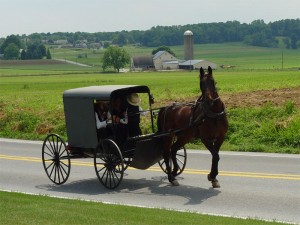No one would equate today’s evangelical church with horse-drawn buggies and straw hats, but I would argue that there is an alarming similarity between the Amish and many of today’s evangelical churches. As odd and out of place as it might seem to zoom past an Amish buggy in the back country of Pennsylvania, a similar trend is manifesting itself in the evangelical world.
Now, without getting into the theological side of the equation, there’s a very practical aspect that marks the Amish as unique: technology and cultural progression. They decided that the late 1800s was as far as they were going to advance technologically in their churches and culture. Culture and technology were fine up to that point, and then they stopped. They planted a stake in the ground and said, “No further.” Their religious movement now has become not just about their theological beliefs but their way of life. They’re trying to defend not just religious principles but a cultural and historical moment in time. That’s what makes them stand out: culturally they have not advanced in 150 years, and holding onto the good ole days of the late 1800s seems just as important to them as advancing their religious beliefs.
So where do evangelicals enter this conversation? I would argue that many churches have the same approach to life and ministry as the Amish do, they’ve just fast-forwarded the clock by a several decades to the 1950s. They’ve decided that it’s not enough to preserve the timeless claims of the gospel. They also need to preserve a way of life, a cultural moment in time, the good ole days when Christianity seemed to be at its zenith in America. For many today stepping into an evangelical church is like stepping into a time machine. Pews, organs, choir robes, large ornate pulpits all hearken back to a time long past that has not been culturally relevant in decades. And like the Amish, many “traditional” churches will defend the sanctity of the 1950s cultural expression of Christianity more than the central claims of Christianity itself.
Rather than spend time and energy reaching out to an ever-changing and ever-dying world, too many evangelical churches are content to hold onto the last remaining cultural vestiges of the 1950s and hold on as long as possible. That’s why so many churches are shutting their doors. The 1950s died out a long time ago.
Fifty years from now, will people walk past today’s churches with their steeples and spires, organs and pews, robes and liturgy with the same sense of bewilderment that we have when we pass by a horse and buggy in Amish country? Are evangelicals becoming the Amish of the 21st century?












